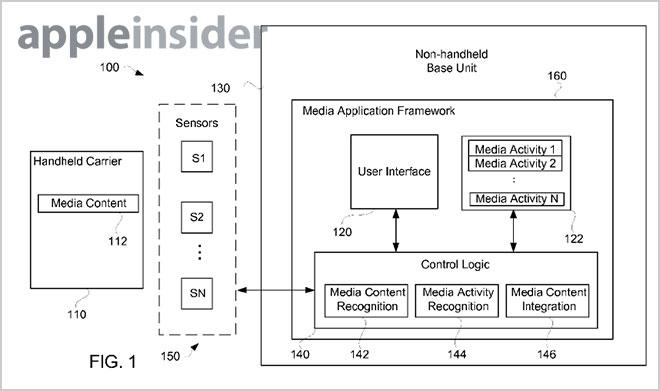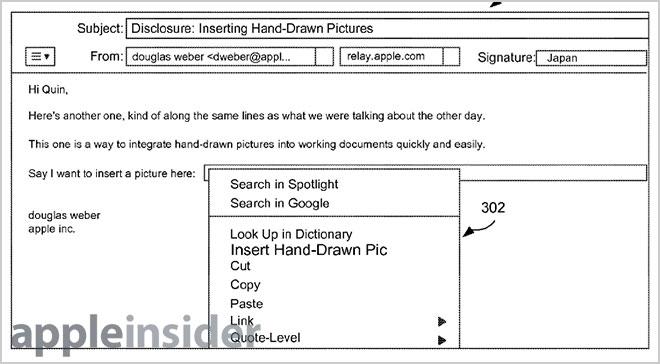An Apple patent published by the U.S. Patent and Trademark Office on Tuesday describes a portable media carrier that can transfer files and documents to a computer, or any recipient device with a display, after said computer senses the device is near.

Source: USPTO
Apple's U.S. Patent No. 8,417,779 for "Apparatus and method for interacting with handheld carrier hosting media content," basically describes a simple system for inserting media from a portable device into an email message, word processing document, photographic editing file, or any other application on a computer.
According to the patent, Apple looks to overcome challenges in interacting with content stored on a portable media device, like transferring media from a host device to a computer, which could be a daunting task for some users.
While not specifically mentioned in the patent language, any iOS device can be used as the "media carrier," as each is of necessary portability and can host the various type of media described, such as photos, video, music and handwritten drawings.

The system is almost completely automated. The host device, being the portable unit, is detected by a second device and initiates a media transfer if it is determined that such an action is desirable. The receiving unit, being a computer or non-handheld device, then inserts the media into an open document window, such as an email message.
For example, a user may want to insert a diagram into an email while typing. Instead of syncing the device or otherwise transferring it through wires or another complex manual method, the user can simply move their iPhone near the computer screen and have the image inserted into the text body. In some embodiments, images can be inserted into an image editing file or other documents running on the computer's screen.
The nuts and bolts of the system are somewhat easily implemented, given the plurality of sensors embedded in Apple's iOS device lineup. To activate the transfer, the patent calls on near field communications (NFC), Bluetooth, a camera or other sensor that can detect the proximity of a portable device in relation to a computer. Once a threshold distance is breached, the system determines that a file transfer is desirable. The patent even notes that even a momentary touch between the devices can be used to trigger the function.
The system then recognizes what type of content is being transferred, and to where, before initiating the transmission. Moving documents and files from one device to the other is done through Bluetooth, Wi-Fi, or any other acceptable wireless protocol.
Perhaps most important to the process is the software framework that initiates and completes the transfer. This interface must determine that media is ready to be acquired, capture the media and insert it into the appropriate running application on the receiving computer. Before doing so, however, the framework decides what type of content is being received, as well as what programs are running on the recipient computer. By determining the media and application activity, the software can intelligently decide what should be taken from the portable device and where it should be inserted.
A user can highlight appropriate media on the handheld device either manually, or by simply having the asset displayed on-screen. They also have the option to select where the media will be inserted through a graphical interface. For example, an option menu or pop-up window containing "Insert Hand-Drawn Pic" can be displayed when transferring a hand-drawn asset.
On that topic, the property notes hand-drawn diagrams can be inserted from the portable media device by using a camera disposed in the recipient computer.
While there are third-party methods that can accomplish some of the functionality described above, such as wireless transfers from an iOS device to one running OS X, Apple's method is unique insofar as the proximity trigger is concerned.
It is unclear if Apple will integrate the feature into a future iPhone or upcoming iteration of iOS, but the hardware called for already exists with the company's portable lineup.
The patent was first applied for in 2010 and credits Douglas Weber as its inventor.